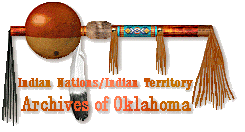The major areas, including the
incorporated towns which made up Haskell County, were
definitely contained in Sans Bois County, Brooken,
Lequire, Hoyt, Kanima, Enterprise, Cartersville, Star
and other small rural communities. Prior to statehood,
as far as " county seat "can be applied to the Choctaw
form of government. The Sans Bois county
courthouse represented the only county seat (prior to
statehood ) . During the transition of statehood and
terms of the Constitutional Convention, Sans Bois
County became Haskell County.
The Sans Bois Mountains, is
situated in the southern portion of the county and two
lakes, the Robert S. Kerr Reservoir from the
east and Lake Eufaula in the west, protrude into the
county in the north. The Robert S. Kerr
Reservoir, has greatly benefitted the county,
especially the town of Keota, making it a shipping
point and attracting industry.
There is significance evidence
that there existed presence of Caddoan-speaking Mound
Builders ( approximately A.D. 850 - 1450 in the areas
of the two rivers. This has been documented by
archaeological evidence. The Choctaw, Witchita,
Chicksaw, Osage and Quapaw hunted in this area of
eastern Oklahoma before European contact. In
1831 The Choctaws began arriving from there forced
removal to the newly created Choctaw Nation, which
included Haskell County, A few came by
steamboat and landed at Tamaha.
As statehood approached the
Choctaw government dealt with allotment, losing
the rights to its Segregated Coal Lands and lastly its
right to self-government, Chief Greenwood McCurtain
held the office of principle chief. Chief
McCurtain, the last of the three McCurtain brothers,
the last to hold this important position, lived and
made his headquarters at Sans Bois, in southern
Haskell County. When Chief McCurtain's term expired in
1904, he was appointed as lifetime chief by President
Theodore Roosevelt and served after statehood in 1907
until his death on December 27,
1910.









